In the biopic Bismarck, Teil. 1/Bismarck (Ernst Wendt, 1925), Franz Ludwig appeared as the famous German politician Otto von Bismarck, while his son Ralph Ludwig played Bismarck as a boy. Bismarck is another example of the Prussian films made during the Weimar republic. The film deals chronologically with the various stages of the life of young Otto von Bismarck: from his childhood through his academic years to his first political experience as a confessed conservative in the German province. The film ends in 1862 when King Wilhelm I appoints Bismarck as Minister President of Prussia. Tomorrow, EFSP will post on part 2.
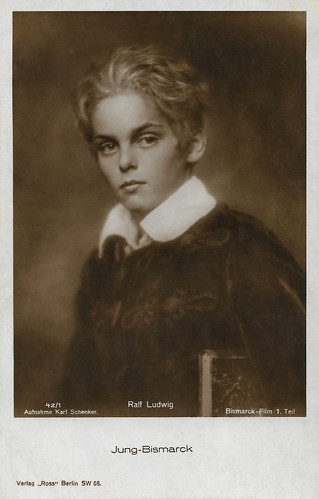
German postcard by Ross Verlag, no. 42/1. Photo: Karl Schenker. Publicity still for Bismarck, Teil. 1 (Ernst Wendt, 1925), starring Franz Ludwig as Otto von Bismarck and Ralph Ludwig as the young Bismarck.
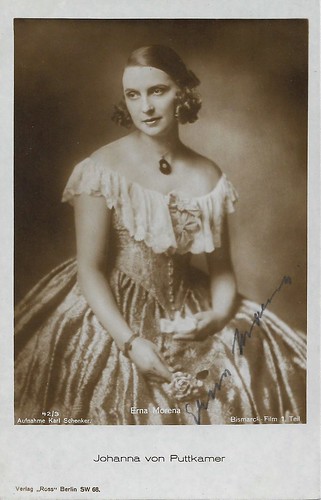
German postcard by Ross Verlag, no. 42/3. Signed by Erna Morena. Photo: Karl Schenker. Publicity still for Bismarck, Teil. 1 (Ernst Wendt, 1925), starring Franz Ludwig as Otto von Bismarck and Erna Morena as his wife, Johanna von Bismarck, née Puttkamer.
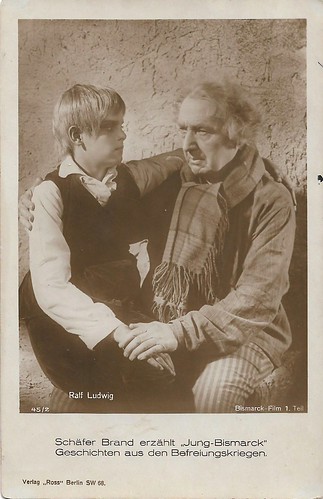
German postcard by Ross Verlag, no. 45/2. Photo: Bismarck-Film. Publicity still for Bismarck, Teil. 1 (Ernst Wendt, 1925), with Ralph Ludwig as young Bismarck. Caption: Schäfer Brand erzählt "Jung-Bismarck" Geschichten aus den Befreiungskriegen (Shepherd Brand narrates young Bismarck about the liberation wars). Meant are the 1813-1815 wars of the Prussians and their allies against Napoleon.
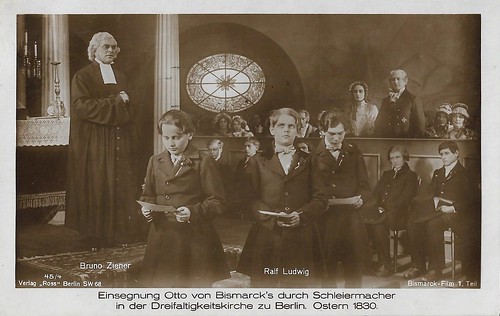
German postcard by Ross Verlag, no. 45/4. Photo: Bismarck-Film. Publicity still for Bismarck, Teil. 1 (Ernst Wendt, 1925), with Ralph Ludwig as young Bismarck and Bruno Ziener as Schleiermacher. Caption: Einsegnung Otto von Bismarck's durch Schleiermacher in der Dreifaltigkeitskirche zu Berlin. Ostern 1830 (Otto von Bismarck's confirmation by Schleiermacher in the Trinity Church in Berlin. Easter 1830.)
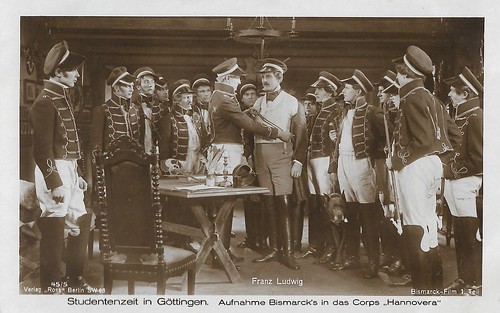
German postcard by Ross Verlag, no. 45/5. Photo: Bismarck-Film. Publicity still for Bismarck, Teil. 1 (Ernst Wendt, 1925), starring Franz Ludwig as Otto von Bismarck. Caption: Studentenzeit in Göttingen. Aufnahme Bismarck's in das Corps "Hannovera" (Student years in Göttingen. Bismarck's admission to the Corps 'Hannovera').
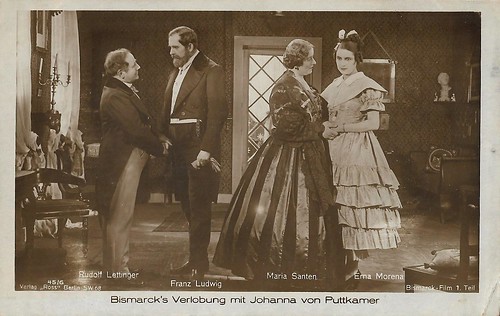
German postcard by Ross Verlag, no. 45/6. Photo: Bismarck-Film. Publicity still for Bismarck, Teil. 1 (Ernst Wendt, 1925). Caption: Bismarck's Verlobung mit Joahnna von Puttkammer (Bismarck's betrothal to Johanna von Puttkamer). Franz Ludwig as Otto von Bismarck, Erna Morena as Johana von Puttkamer, also with Rudolf Lettinger and Maria Santen.
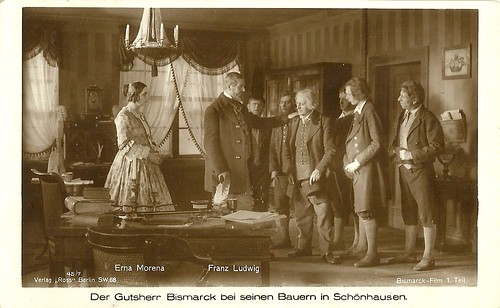
German postcard by Ross Verlag, no. 45/7. Photo: Bismarck-Film. Publicity still for Bismarck, Teil. 1 (Ernst Wendt, 1925), starring Franz Ludwig as Otto von Bismarck and Erna Morena as his wife Johanna. Caption: Der Gutsherr Bismarch bei seinen Bauern in Schönnhausen (Squire Bismarck with his farmers at Schönnhausen).
The two-part Bismarck-Film (1925-1926) was one of the most ambitious film projects of the Weimar Republic. The two films were inspired by the loss of the First World War and producer Josef Coböken wanted to give the German youth a new patriotic spirit based on the German national history. For this film he founded a special production company, the Bismarck-Film GmbH.
No expenses and efforts were spared, and the film makers received the support of the very highest body of the state. The freshly appointed Reich President Paul von Hindenburg became the patron of the mammoth project. Several famous experts were hired for the film: Ludwig Manzel for the artistic consultation, Colonel von Hahnke for the military consultation, the sculptor Hans Sametzki was the expert for the preparation of the historical masks (Bismarck, Wilhelm I, Moltke etc.) and the military expert Herbert Knötel was consulted for the uniforms and weaponry.
The Bismarck-Film project was created from the beginning in two parts. Bismarck, Teil. 1 (Ernst Wendt, 1925) deals with the period from 1815 to 1862, and the second part, Bismarck-Film, 2. Teil/Bismarck 1862-1898 (Kurt Blachnitzky, 1926), deals with Bismarck's late, decisive years as Prussian Prime Minister and German Chancellor.
Bismarck, Teil. 1 (Ernst Wendt, 1925) was based on a screenplay, for which IMDb credits Max Jungk, Julius Urgiss and Ludwig Ziehen as the authors. In fact it was written by Ludwig Ziehen, who paid meticulous attention to the historical details in scientific collaboration with historian Erich Marcks and philosopher, physician, and psychologist Max Dessoir. The two experienced authors Max Jungk and Julius Urgiss appeared merely as editors of Ziehen's manuscript.
In 1935, Oscar Kalbus wrote about the film: "The film Bismarck (1925), however, does not want to be a feature film right from the start, nor does it mean to be a film drama or an average historical film. It wants to be seen as a historical document, as a monumental panorama of moving images. If one does not demand more of the film, one can address Bismarck as a national folk film. All the masks in the Bismarck film are admirably portrayed, true to life, never rigid and theatrical."
For the 49-year-old director Ernst Wendt, Bismarck, Teil. 1 was his last feature film as a director.
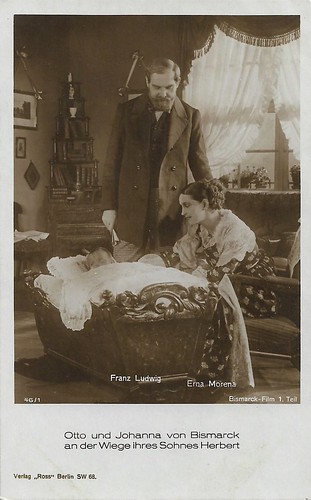
German postcard by Ross Verlag, no. 46/1. Photo: Bismarck-Film. Publicity still for Bismarck, Teil. 1 (Ernst Wendt, 1925), starring Franz Ludwig as Otto von Bismarck and Erna Morena as his wife Johanna. Caption: Otto und Johanna von Bismarck an der Wiege ihres Sohnes Herbert (Otto and Johanna von Bismarck at the cradle of their son Herbert).
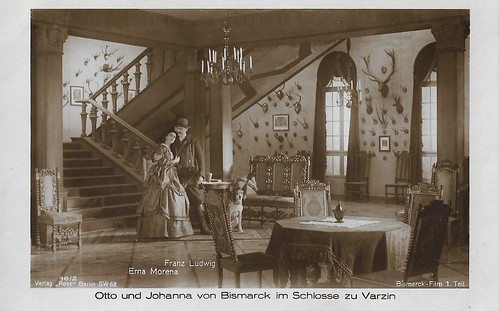
German postcard by Ross Verlag, no. 46/2. Photo: Bismarck-Film. Publicity still for Bismarck, Teil. 1 (Ernst Wendt, 1926), starring Franz Ludwig as Otto von Bismarck and Erna Morena as his wife Johanna. Caption: Otto and Johanna Bismarck in their castle at Varzin.
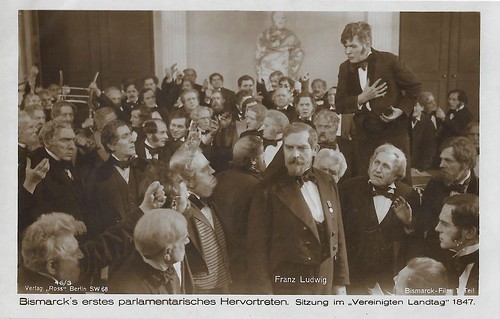
German postcard by Ross Verlag, no. 46/3. Photo: Bismarck-Film. Publicity still for Bismarck, Teil. 1 (Ernst Wendt, 1926), starring Franz Ludwig as Otto von Bismarck. Caption: Bismarck's erstes parlementarisches Hervortreten. Sitzung im "Vereinigten Landtag" 1847 (Bismarck's first parliamentary performance. Meeting at the Vereinigten Landtag (regional parliament), 1847).
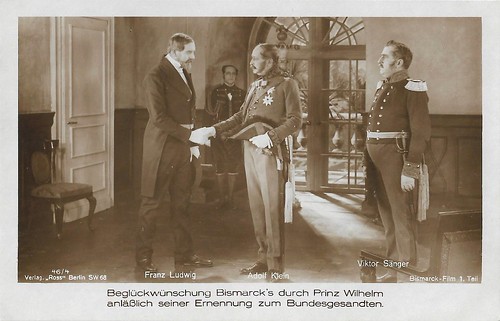
German postcard by Ross Verlag, no. 46/4. Photo: Bismarck-Film. Publicity still for Bismarck, Teil. 1 (Ernst Wendt, 1926), starring Franz Ludwig as Bismarck, and with Adolf Klein and Viktor Sänger. Caption: Prince Wilhelm's congratulations to Bismarck at his appointment as a member of parliament. Wilhelm (Adolf Klein) is the future king Wilhelm of Prussia, whom Bismarck made Emperor of Germany in 1871.
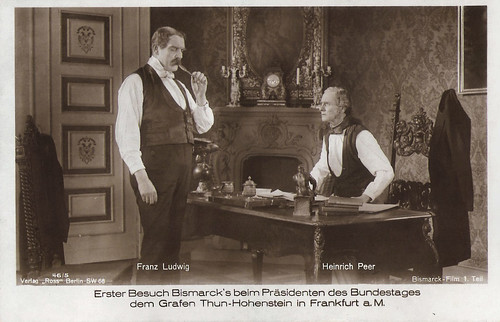
German postcard by Ross Verlag, no. 46/5. Photo: Bismarck-Film. Publicity still for Bismarck, Teil. 1 (Ernst Wendt, 1925) with Franz Ludwig as Otto von Bismarck and Heinrich Peer as Count Thun-Hohenstein. Caption: Erster Besuch Bismarck's beim Präsidenten des Bundestages dem Grafen Thun-Hogenstein in Frankfurt a. M. (The first visit of Bismarck at the president of the Bundestag, Count Thun-Hohenstein).
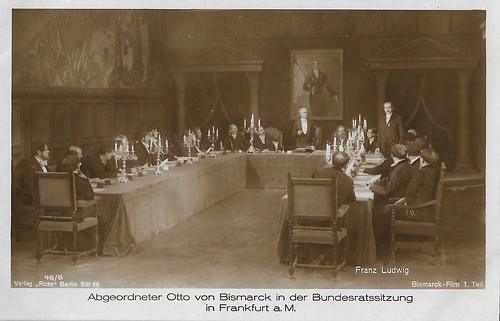
German postcard by Ross Verlag, no. 46/6. Photo: Bismarck-Film. Publicity still for Bismarck, Teil. 1 (Ernst Wendt, 1925) with Franz Ludwig. Caption: Abgeordneter Otto von Bismarck in der Bundesratssitzung in Frankfurt a. M. (Delegate Otto von Bismarck representative in the federal council meeting in Frankfurt am Main).
Sources: Wikipedia (German and English), and IMDb.

German postcard by Ross Verlag, no. 42/1. Photo: Karl Schenker. Publicity still for Bismarck, Teil. 1 (Ernst Wendt, 1925), starring Franz Ludwig as Otto von Bismarck and Ralph Ludwig as the young Bismarck.

German postcard by Ross Verlag, no. 42/3. Signed by Erna Morena. Photo: Karl Schenker. Publicity still for Bismarck, Teil. 1 (Ernst Wendt, 1925), starring Franz Ludwig as Otto von Bismarck and Erna Morena as his wife, Johanna von Bismarck, née Puttkamer.

German postcard by Ross Verlag, no. 45/2. Photo: Bismarck-Film. Publicity still for Bismarck, Teil. 1 (Ernst Wendt, 1925), with Ralph Ludwig as young Bismarck. Caption: Schäfer Brand erzählt "Jung-Bismarck" Geschichten aus den Befreiungskriegen (Shepherd Brand narrates young Bismarck about the liberation wars). Meant are the 1813-1815 wars of the Prussians and their allies against Napoleon.

German postcard by Ross Verlag, no. 45/4. Photo: Bismarck-Film. Publicity still for Bismarck, Teil. 1 (Ernst Wendt, 1925), with Ralph Ludwig as young Bismarck and Bruno Ziener as Schleiermacher. Caption: Einsegnung Otto von Bismarck's durch Schleiermacher in der Dreifaltigkeitskirche zu Berlin. Ostern 1830 (Otto von Bismarck's confirmation by Schleiermacher in the Trinity Church in Berlin. Easter 1830.)

German postcard by Ross Verlag, no. 45/5. Photo: Bismarck-Film. Publicity still for Bismarck, Teil. 1 (Ernst Wendt, 1925), starring Franz Ludwig as Otto von Bismarck. Caption: Studentenzeit in Göttingen. Aufnahme Bismarck's in das Corps "Hannovera" (Student years in Göttingen. Bismarck's admission to the Corps 'Hannovera').

German postcard by Ross Verlag, no. 45/6. Photo: Bismarck-Film. Publicity still for Bismarck, Teil. 1 (Ernst Wendt, 1925). Caption: Bismarck's Verlobung mit Joahnna von Puttkammer (Bismarck's betrothal to Johanna von Puttkamer). Franz Ludwig as Otto von Bismarck, Erna Morena as Johana von Puttkamer, also with Rudolf Lettinger and Maria Santen.

German postcard by Ross Verlag, no. 45/7. Photo: Bismarck-Film. Publicity still for Bismarck, Teil. 1 (Ernst Wendt, 1925), starring Franz Ludwig as Otto von Bismarck and Erna Morena as his wife Johanna. Caption: Der Gutsherr Bismarch bei seinen Bauern in Schönnhausen (Squire Bismarck with his farmers at Schönnhausen).
To give the German youth a new patriotic spirit
The two-part Bismarck-Film (1925-1926) was one of the most ambitious film projects of the Weimar Republic. The two films were inspired by the loss of the First World War and producer Josef Coböken wanted to give the German youth a new patriotic spirit based on the German national history. For this film he founded a special production company, the Bismarck-Film GmbH.
No expenses and efforts were spared, and the film makers received the support of the very highest body of the state. The freshly appointed Reich President Paul von Hindenburg became the patron of the mammoth project. Several famous experts were hired for the film: Ludwig Manzel for the artistic consultation, Colonel von Hahnke for the military consultation, the sculptor Hans Sametzki was the expert for the preparation of the historical masks (Bismarck, Wilhelm I, Moltke etc.) and the military expert Herbert Knötel was consulted for the uniforms and weaponry.
The Bismarck-Film project was created from the beginning in two parts. Bismarck, Teil. 1 (Ernst Wendt, 1925) deals with the period from 1815 to 1862, and the second part, Bismarck-Film, 2. Teil/Bismarck 1862-1898 (Kurt Blachnitzky, 1926), deals with Bismarck's late, decisive years as Prussian Prime Minister and German Chancellor.
Bismarck, Teil. 1 (Ernst Wendt, 1925) was based on a screenplay, for which IMDb credits Max Jungk, Julius Urgiss and Ludwig Ziehen as the authors. In fact it was written by Ludwig Ziehen, who paid meticulous attention to the historical details in scientific collaboration with historian Erich Marcks and philosopher, physician, and psychologist Max Dessoir. The two experienced authors Max Jungk and Julius Urgiss appeared merely as editors of Ziehen's manuscript.
In 1935, Oscar Kalbus wrote about the film: "The film Bismarck (1925), however, does not want to be a feature film right from the start, nor does it mean to be a film drama or an average historical film. It wants to be seen as a historical document, as a monumental panorama of moving images. If one does not demand more of the film, one can address Bismarck as a national folk film. All the masks in the Bismarck film are admirably portrayed, true to life, never rigid and theatrical."
For the 49-year-old director Ernst Wendt, Bismarck, Teil. 1 was his last feature film as a director.

German postcard by Ross Verlag, no. 46/1. Photo: Bismarck-Film. Publicity still for Bismarck, Teil. 1 (Ernst Wendt, 1925), starring Franz Ludwig as Otto von Bismarck and Erna Morena as his wife Johanna. Caption: Otto und Johanna von Bismarck an der Wiege ihres Sohnes Herbert (Otto and Johanna von Bismarck at the cradle of their son Herbert).

German postcard by Ross Verlag, no. 46/2. Photo: Bismarck-Film. Publicity still for Bismarck, Teil. 1 (Ernst Wendt, 1926), starring Franz Ludwig as Otto von Bismarck and Erna Morena as his wife Johanna. Caption: Otto and Johanna Bismarck in their castle at Varzin.

German postcard by Ross Verlag, no. 46/3. Photo: Bismarck-Film. Publicity still for Bismarck, Teil. 1 (Ernst Wendt, 1926), starring Franz Ludwig as Otto von Bismarck. Caption: Bismarck's erstes parlementarisches Hervortreten. Sitzung im "Vereinigten Landtag" 1847 (Bismarck's first parliamentary performance. Meeting at the Vereinigten Landtag (regional parliament), 1847).

German postcard by Ross Verlag, no. 46/4. Photo: Bismarck-Film. Publicity still for Bismarck, Teil. 1 (Ernst Wendt, 1926), starring Franz Ludwig as Bismarck, and with Adolf Klein and Viktor Sänger. Caption: Prince Wilhelm's congratulations to Bismarck at his appointment as a member of parliament. Wilhelm (Adolf Klein) is the future king Wilhelm of Prussia, whom Bismarck made Emperor of Germany in 1871.

German postcard by Ross Verlag, no. 46/5. Photo: Bismarck-Film. Publicity still for Bismarck, Teil. 1 (Ernst Wendt, 1925) with Franz Ludwig as Otto von Bismarck and Heinrich Peer as Count Thun-Hohenstein. Caption: Erster Besuch Bismarck's beim Präsidenten des Bundestages dem Grafen Thun-Hogenstein in Frankfurt a. M. (The first visit of Bismarck at the president of the Bundestag, Count Thun-Hohenstein).

German postcard by Ross Verlag, no. 46/6. Photo: Bismarck-Film. Publicity still for Bismarck, Teil. 1 (Ernst Wendt, 1925) with Franz Ludwig. Caption: Abgeordneter Otto von Bismarck in der Bundesratssitzung in Frankfurt a. M. (Delegate Otto von Bismarck representative in the federal council meeting in Frankfurt am Main).
Sources: Wikipedia (German and English), and IMDb.
No comments:
Post a Comment